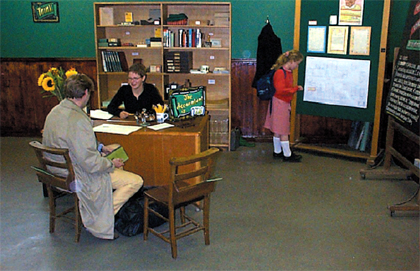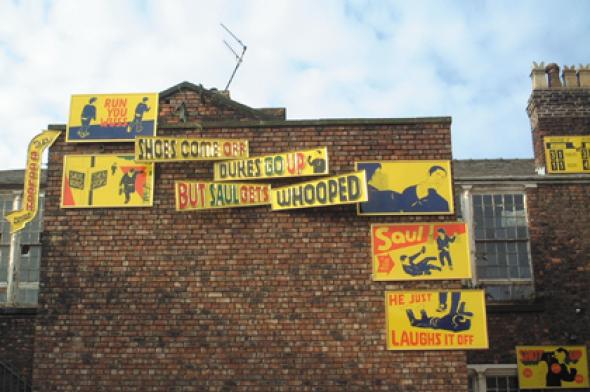Liverpool's Art Haul
Josephine Berry visits the Liverpool Biennial 2002 and finds yet another city attempting to re-position itself in the post-industrial and post-colonial world through the power of art and culture
‘You’ll never walk alone’ seems to have become not just the anthem of Liverpool FC but of the city’s curatorial class as well, as it falls into step with all the other cultural and municipal managers gripped by the worldwide epidemic of biennial mania. The ‘biennial effect’, like the song, is as much an article of faith, a rallying cry, as it is a demonstrable fact. Its salutary effects are deemed to include the restimulation of a city’s economic growth in the ‘post-industrial’ age, the general redress of the art world’s endemic eurocentrism, the articulation of global culture under the conditions of global capitalism with its associated mass migrations and deterritorialisations, and the negotiation of art’s ‘place’ and function within this fragmented landscape beyond the white cube.
The epic scale of this year’s second Liverpool Biennial is a reflection of the massive scope of this ambition. Amidst the hulk of the city’s decaying, imperial-industrial splendours were scattered the Biennial’s myriad parts. These included: the International 2002 (the event’s central exhibition spread across the three venues of the Tate, the Bluecoat Arts Centre, the Pleasant Street School and other site-specific locations); the Independent 2002 (sixteen independently curated shows put on at the city’s independent galleries and other temporary venues); the Bloomberg New Contemporaries Exhibition; the John Moores 22 Exhibition of Contemporary Painting (offering a first prize of £25,000) a programme of live arts called You Are Here; and a series of screenings on the side of the Holiday Inn titled Watching Ocean and Sky Together.
Unlike Okwui Enwezor’s much-debated Documenta however, the curators of International 2002 have avoided subjecting the work to any overarching thematic treatment. In the words of Biennial chief Lewis Biggs, the exhibition as a whole is ‘not a manifesto or a philosophical essay’. The curatorial plurality of the Biennial’s component parts also added to the sense that the event’s only thesis was the city itself and the role culture now plays for it. Since Liverpool, in Biggs’ words again, ‘was the city of Empire’ and has since become ‘the city representing the loss of Empire’, this turned out to be an extremely eloquent setting for the hybrid cultural alignments and site-specific sensitivity of contemporary art practice. Where Liverpool once served as Britain’s main port serving the American trade routes – the gateway between all the people, cultures and goods that colonialism put so wrenchingly in motion – it was temporarily transformed into a depot for the huge global trade in culture.

> Christine Hill, The Volksboutique Accounting Archive, 2002 at Pleasant Street Board School. Henry Moore Foundation Contemporary Projects
US artist Christine Hill’s Volksboutique Accounting Archive (2002) in which the artist and her assistant inventorised visitors’ stories about the city, attempted a related transformation of materiality (the practice of art as aesthetics) into immateriality (the artist as service provider and site as information). But the nostalgic recreation of a prewar office setting, not to mention Hill’s misguided belief in the localness of an art audience able to supply such stories, revealed her unwillingness to grasp the consequences of such a transformation and the realities of global info-capitalism. At the other extreme, Mexican performance artist Guillermo Gómez-Peña and his band of international ‘specimens’ enacted ‘a living Diorama of Fetish-ized Others’ in the performance Ex-Centris. Colliding orientalist, primitivist, pop-futurist, and transgressive clichés of identity, the performers apparently indulged our fantasies and phobias of the Other. The crassness of the clichés confronted the audience with the bankrupt equivalence of these fantastical identity types and begged the question of how they continue to hold sway in the age of mediatised globalisation.

> The Volksboutique Accounting Archive
Of the works I saw, the one that seemed to engage most directly with the question of art’s location amidst the disappearance of public space was the Japanese artist Tatsuro Bashi’s Villa Victoria. A monument to Queen Victoria on Derby Square was enveloped in a specially constructed hotel bedroom so that the lugubrious figure now loomed within a domestic setting, complete with en suite bathroom, magazine racks and wall-to-wall carpeting. This surreal displacement staged the wider blurring of public and private space within contemporary capitalism. But, as with most of the works in the Biennial, Villa Victoria lacked any detailed information about the process of negotiation between city councillors, sponsors, and curators that preceded its realisation. The very mechanisms of the city’s transformation remained effectively obscure. But when one discovers that the Biennial is a crucial part of Liverpool’s bid to become European City of Culture 2008 – a bid which will net £35m in funding for the city and, if successful, is estimated to create 12,000 jobs – the assimilation of the old totem of monarchical power into the new totem of art power seems like a profound if inadvertent symbol.
Liverpool Biennial // 14 September – 24 November 2002 [http://www.biennial.org.uk]
Josephine Berry <josieATmetamute.com> is deputy editor of Mute magazine
Mute Books Orders
For Mute Books distribution contact Anagram Books
contact@anagrambooks.com
For online purchases visit anagrambooks.com








